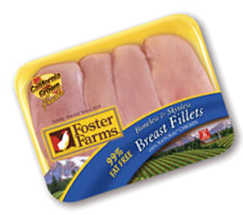In June 2012, the Oregon Health Authority and the Washington State Department of Health noted an increase in the number of Salmonella enterica serotype Heidelberg clinical isolates sharing an identical pulsed-field gel electrophoresis (PFGE) pattern. In 2004, this pattern had been linked to chicken from Foster Farms by the Washington State Department of Health; preliminary 2012 interviews with infected persons also indicated exposure to Foster Farms chicken.
 In the end, at least 634 Americans were sickened with Salmonella Heidelberg, all linked to Foster Farms, from 2013-2014.
In the end, at least 634 Americans were sickened with Salmonella Heidelberg, all linked to Foster Farms, from 2013-2014.
Here is the scientific write-up of that outbreak, or I’m completely wrong in my interpretation and will blame the painkillers.
Importance
This large outbreak of foodborne salmonellosis demonstrated the complexity of investigating outbreaks linked to poultry products. The outbreak also highlighted the importance of efforts to strengthen food safety policies related to Salmonella in the chicken parts and has implications for future changes within the poultry industry.
Objective
To investigate a large multistate outbreak of multidrug resistant Salmonella Heidelberg infections.
Design
Epidemiologic and laboratory investigations of patients infected with the outbreak strains of Salmonella Heidelburg and traceback of possible food exposures.
Setting
United States. Outbreak period was March 1, 2013 through July 11, 2014
A case was defined as illness in a person infected with a laboratory-confirmed Salmonella Heidelburg with 1 of 7 outbreak pulsed-field gel electrophoresis (PFGE) Xbal pattern with illness onset from March 1, 2013 through July 11, 2014. A total of 634 case-patients were identified through passive surveillance; 200/528 (38%) were hospitalized, none died.
Results
Interviews were conducted with 435 case-patients interviewed with a focused questionnaire, 201 (74%) reported eating chicken prepared at home. Among case-patients with available brand information, 152 (87%) of 175 patients reported consuming Company A brand chicken. Antimicrobial susceptibility testing was completed on 69 clinical isolates collected from case-patients; 67% were drug resistant, including 24 isolates (35%) that were multidrug resistant. The source of Company A brand chicken consumed by case-patients was traced back to 3 California production establishments from which 6 of 7 outbreak strains were isolated.
Conclusions
Epidemiologic, laboratory, traceback, and environmental investigations conducted by local state, and federal public health and regulatory officials indicated that consumption of Company A chicken was the cause of this outbreak. The outbreak involved multiple PFGE patterns, a variety of chicken products, and 3 production establishments, suggesting a reservoir for contamination upstream from the production establishments. Sources of bacteria and genes responsible for resistance, such as farms providing birds for slaughter environmental reservoir on farms that raise chickens, might explain how multiple PFGE patterns were linked to chicken form 3 separate production establishments and many different poultry products.
National outbreak of multidrug resistant Salmonella Heidelberg infections linked to a single poultry company
PLoS ONE, 11(9), doi:10.1371/journal.pone.0162369
http://forum.efeedlink.com/contents/07-05-2017/976bf575-6e5a-4067-a763-0598a663f48d-c784.html

